Hippeastrum x hybridum
For large, showy spring flowers in USDA Hardiness Zones 9 to 11, you can’t beat the hand-sized, lily-like blooms of amaryllis, Hippeastrum x hybridum.
These tropical beauties can also be forced to bloom indoors during the winter holidays in all growing zones, and then guided through dormancy for blooms in successive years.
In our guide to growing amaryllis indoors, we discuss how to care for potted plants.
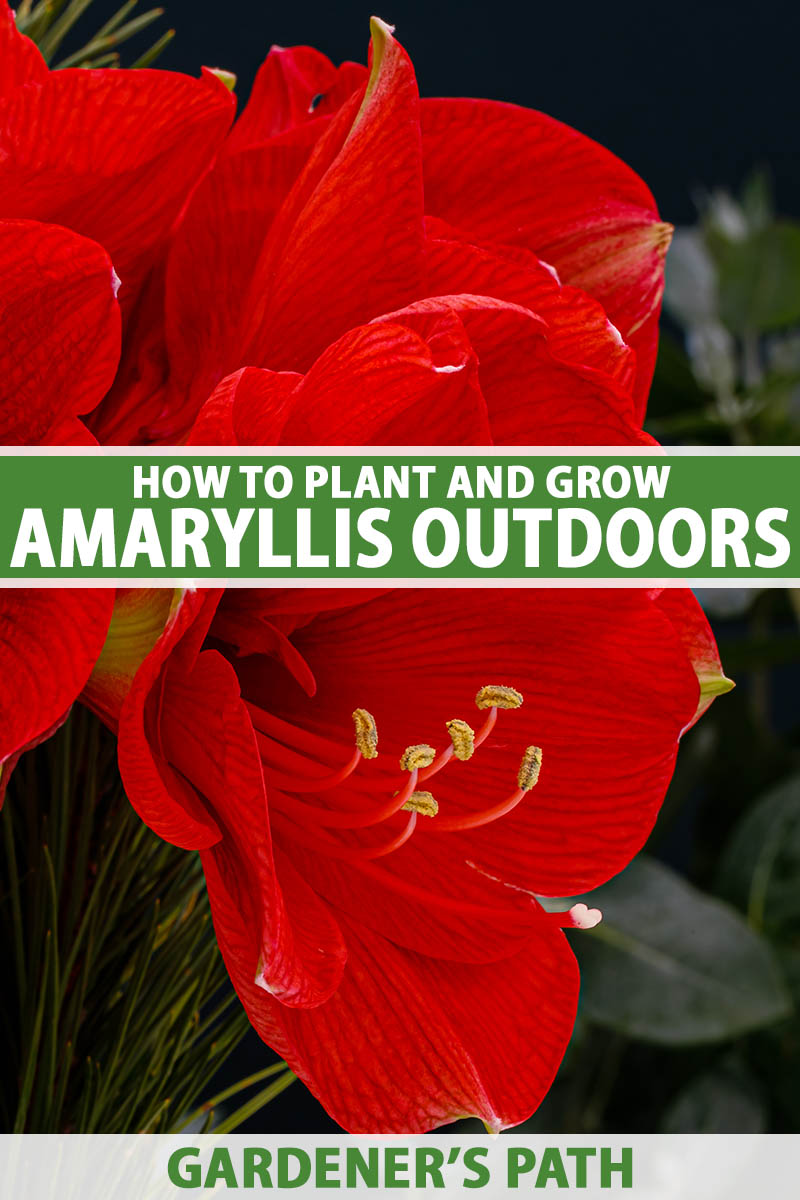
We link to vendors to help you find relevant products. If you buy from one of our links, we may earn a commission.
In this article, we share all you need to know to grow amaryllis outdoors in the garden or containers, in areas where the weather is conducive to their perennial cultivation.
Here’s what’s in store:
What You’ll Learn
Let’s start with a little background.
An Amaryllis Primer
It all started in the 1700s, when Swedish botanist Charles Linneaus created the Amaryllis genus to classify Amaryllis belladonna, a South African flower with star-shaped blossoms that is now commonly known as the Jersey lily.
In the 1800s, a British botanist named William Herbert described multiple South American star-like blooms as “knight’s stars,” which translates to Hippeastrum in Latin, and created a new genus.

For many years, it was commonplace for both the South African and South American lily-like species, which bear some resemblance to each other, to be classified as Amaryllis.
It wasn’t until the 14th International Botanical Congress of 1987 that botanists decreed that there are indeed two separate genera, and all the South American species were classified as Hippeastrum.
However, old habits die hard, and today Hippeastrum species and hybrids are still commonly known as amaryllis.
By either name, these South and Central American species and the numerous cultivated varieties, are the topic of this guide.
They are truly show-stoppers in the garden, blooming in shades of orange, pink, purple, red, white, and yellow, as well as variegated patterns.
Hybrids vary widely and include Nymphs with multiple layers of petals, Cybisters with especially narrow petals, and Papilios that resemble butterflies.
Bulbs vary in size from 10 to 14 inches in diameter. Each bulb sprouts between one and three flower stems, called scapes, that rise to heights of 12 to 36 inches.
When grown outdoors, these plants naturally bloom in springtime, the ones we enjoy as holiday houseplants have been forced to bloom indoors during the winter months.
The scapes bear four to six lily-like blooms with diameters ranging from four to 10 inches, and flowers bloom in succession for several weeks.
Strappy green leaves sprout beside the scapes, and may reach up to 36 inches in length. After the flowers have finished blooming, these leaves continue to provide nourishment to the bulb until they turn yellow and wither, in time for winter dormancy.
As tender perennials, they can’t tolerate frost but in cooler locations, they can be planted outdoors as annuals and lifted from the ground in fall for overwintering.
Getting Started
To cultivate an amaryllis plant of your own, you’ll need to start from a bulb, seed, divided offset, or bulb section.
The easiest way is to purchase a dormant bulb from a quality purveyor. They vary in size, with the largest typically offering the greatest potential for multiple scapes and flowers per scape.
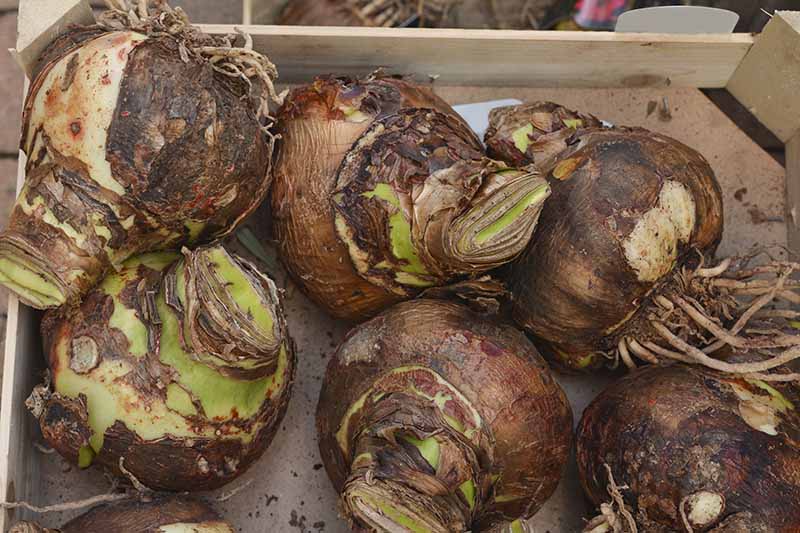
If you have an existing plant, it is possible to collect seeds after the flowers finish blooming.
However, plants grown from seed may take up to five years to mature and bloom, and those collected from hybrid cultivars will not produce true to the parent plant.
You can learn more about how to cultivate amaryllis from seed in our guide.
Instead of collecting seeds, offset division and bulb resectioning are easily accomplished with mature plants. These techniques will result in clones of the parent plant.
Check out our guide to propagating amaryllis bulbs for full instructions.
How to Grow
If you’re in Zones 9 to 11, and received a potted bulb as a winter gift, you can enjoy it over the holidays and transplant it to the garden in the spring, where it will revert to its natural tendency to bloom in springtime in a year or so.
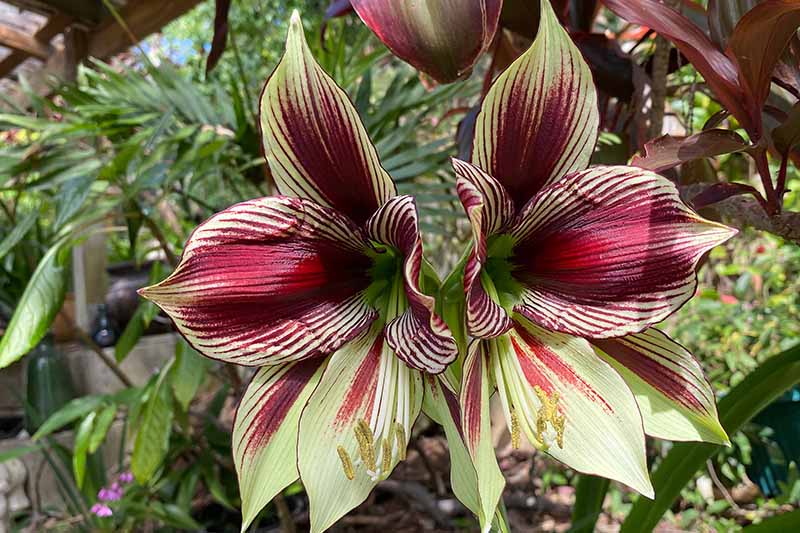
You can also purchase dormant bulbs and do your planting in the fall. The bulbs will overwinter in the ground, ready to bloom in the spring.
In cooler regions, you can also grow these flowers as annuals, and either lift the bulbs in fall for replanting the following spring or grow them in containers that can be overwintered in a frost-free location.
If you want your flower to bloom during the winter holidays, keep in mind that it will need to be forced, this will not happen naturally in the Northern Hemisphere.
Outdoor Garden Cultivation
To grow outdoors year-round in the frost-free zones, choose a location with full sun to part shade. Avoid full shade, as it may result in poor flower production.
The soil should be organically-rich and well-draining, with a slightly acidic pH of 6.0 to 6.5.
Choose a sheltered location, as high winds can damage the long flower stalks.
Dormant bulbs can be planted in the spring or fall, and those that have bloomed indoors in the winter can be transplanted in spring with the foliage intact.
Place the bulb neck-deep in the soil, leaving about one-third of the pointed top – and any foliage that may be present – exposed.
Space them 12 to 15 inches apart in odd-numbered groupings for best visual appeal, and to give plants adequate space to bloom.
For spring plantings, keep the soil moist until foliage emerges, and then water sparingly thereafter in the absence of rain to maintain moisture, but avoid waterlogged conditions that can lead to rotting. Once established, plants are drought resistant.
Add an inch or so of mulch around, but not over, the neck of the bulbs, to inhibit weeds and the pests and diseases they may harbor, and aid in moisture retention.
Apply a well-balanced, slow-release fertilizer at the time of planting, such as 6-6-6 or 10-10-10 (NPK). It promotes lush foliage and boosts the nutrition for next year’s flowers.
Container Gardening
In addition to the garden, you may also grow your amaryllis in containers with adequate drainage holes. A shallow depth is suitable, as these plants like to be somewhat root bound.
Provide a snug fit with a standard pot that has a diameter that allows for only one to two inches of space around the bulb.

Fill the container with a well-draining potting medium to a height that is one inch below the rim, to allow room for watering.
Place it in a full sun to part shade location, and water only when the soil is dry to an inch down.
During very hot, dry weather, keep a close eye on your containers as you don’t want them to dry out completely.
You may move container plants into part shade after they finish blooming, as desired.
Bringing Bulbs Indoors for the Winter
Those in cooler climes who put indoor winter-blooming potted bulbs outdoors for the summer – or are growing these plants as annuals – need to take them inside again before the first frost.
Here’s how:
By summer’s end, the leaves fade to yellow and then turn brown. Cut off any remaining foliage to a height of about an inch, and bring container-grown plants back indoors. Do this before the first frost in cold regions.
Before returning a pot to the house, apply neem oil, a natural fungicide and pesticide, and allow time for the entire container to dry before bringing it inside.
Alternatively, dig the bulb up, discard the old potting soil, and keep it loose, or repot it in a fresh sterile medium.
For plants growing in the garden, you can dig them up, clean off the soil, and either pot them up in sterile medium, or store them loose during dormancy.
Store them potted or loose in a cool, dry location, with a temperature in the range of 45 to 50°F. Loose bulbs can be gently washed, dried, and stored in a cardboard box.
Do not water at all during the dormancy period.
After 10 to 12 weeks of dormancy, you can pot up loose bulbs and move containers to a 75 to 80°F location where they can sprout. Alternatively, you can plant them out in the garden after all risk of frost has passed.
Under ideal conditions, you may get a re-bloom in the second and/or successive years.
Growing Tips
- Group by odd-numbers for aesthetically pleasing outdoor displays.
- Keep the soil evenly moist until the first sprout appears. Then water sparingly.
- Mulch outdoor plants to inhibit weeds and aid in moisture retention.
- Use containers that allow for a snug fit and have adequate drainage holes.
- Return bulbs indoors in regions that freeze.
Maintenance
While a bulb by nature contains the food needed to nourish the plant that emerges from it, after the first bloom, it loses vigor.
To give it a nutrient boost, apply a well-balanced, slow-release fertilizer in late winter, like you did when you first planted.
Take care to avoid products with excessive amounts of nitrogen, or you may have too much foliage and too few blossoms.
Late winter is also the time to begin to water the soil around your bulbs. Keep it moist, but not soggy, until you see the first green sprout. Thereafter, water sparingly.

Before the growing season gets underway, remove and replace old mulch. After a year, it deteriorates from a nutritional standpoint, becomes compacted, and may harbor pests and disease.
Amaryllis is phototropic, so staking may be required for the flower stalks. If you do this, be careful not to pierce or damage the bulbs.
As the growing season draws to a close in late summer, and the foliage has withered, remove it from the garden or container, as the debris may harbor pests and disease.
Late summer to early fall is the time to divide large clumps as desired, by digging bulbs up and separating large offsets from the mother to relocate elsewhere.
We have a seperate guide for post-flowering care that shares other valuable tips.
Cultivars to Select
Now that you’re well acquainted with planting and care, it’s time to consider some of the many gorgeous cultivated varieties available.
Here are three that are sure to whet your appetite:
Grand Diva
A classic that never fails to please, ‘Grand Diva’ commands attention with its robust color saturation.
Velvety, burgundy-red petals are sure to stop the show when four to five richly-hued blooms burst into life atop 20- to 24-inch stems.
You can find ‘Grand Diva’ available at Burpee.
Picotee
‘Picotee’ features eight-inch creamy white petals with red edging atop sturdy, 20- to 25-inch stems.
The large flowers make a bold statement in beds, borders, and containers.
You can find ‘Picotee’ bulbs available at Burpee.
Sweet Lillian
A Cybister hybrid, ‘Sweet Lillian’ bears a great resemblance to the Oriental stargazer lily (Lilium ‘Stargazer’).
Petals appear to be painted with swift strokes of an artist’s brush in ever-brightening pink and magenta on an ivory canvas.
Each 20- to 24-inch stem produces four to six stunning blooms.
You can find ‘Sweet Lillian’ available from Burpee.
For more exciting styles and colors, check out our roundup of 17 of the best amaryllis varieties.
Managing Pests and Disease
When growing outdoors, keep the garden beds or containers free of weeds that may attract disease-carrying insects that nest in and feed on foliage.
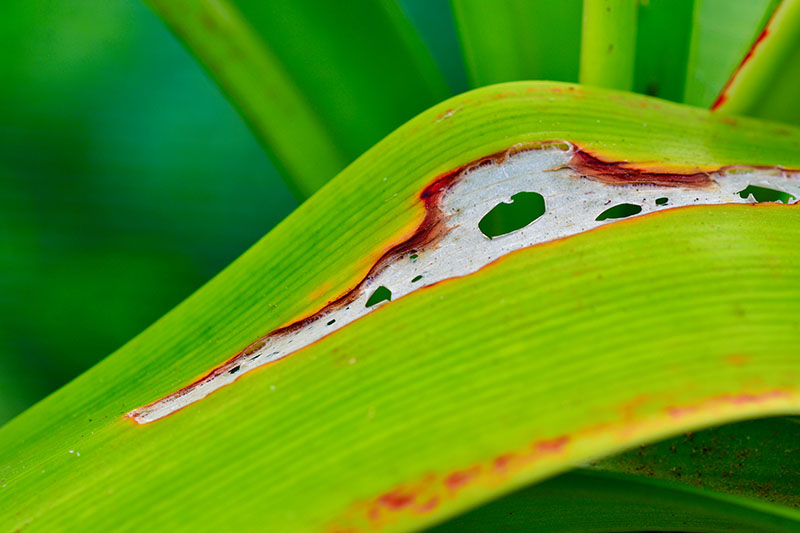
For minor infestations of sap-sucking pests like aphids, mealybugs, spider mites, and thrips, you may be able to rinse them off the foliage with a steady stream of water.
In the case of a large-scale infestation, you might need to apply an insecticidal soap or neem oil.
Fungus gnat larvae feed below the soil and cause foliar deformity. Neem oil is the solution here as well, and it can head off diseases spread by young nymphs, such as wilt and blight.
Another sub-surface pest is the root-knot nematode (Meloidogyne spp.), a type of roundworm.
Learn how to control an infestation of root-knot nematodes in our guide.
Slugs and snails turn up when the soil or potting medium is oversaturated. Avoid overwatering and trap them as needed.
The narcissus bulb fly, Merodon equestris, is a pest that is persistent and hard to eradicate.
Females lay eggs in the early spring foliage. When the larvae emerge, they descend into the bulb and start feeding. Damage is not immediately evident.
Those who lift bulbs in the fall for storage are generally the first to notice that they have become soft and wet and contain one or more grubs.
Treatment includes use of insecticides on emergent spring foliage and a hot water bath for lifted bulbs.
The amaryllis borer is a caterpillar that may have a feast both above and below ground. Hand pick it, introduce a caterpillar predator to the garden, or apply neem oil to get rid of this pest.
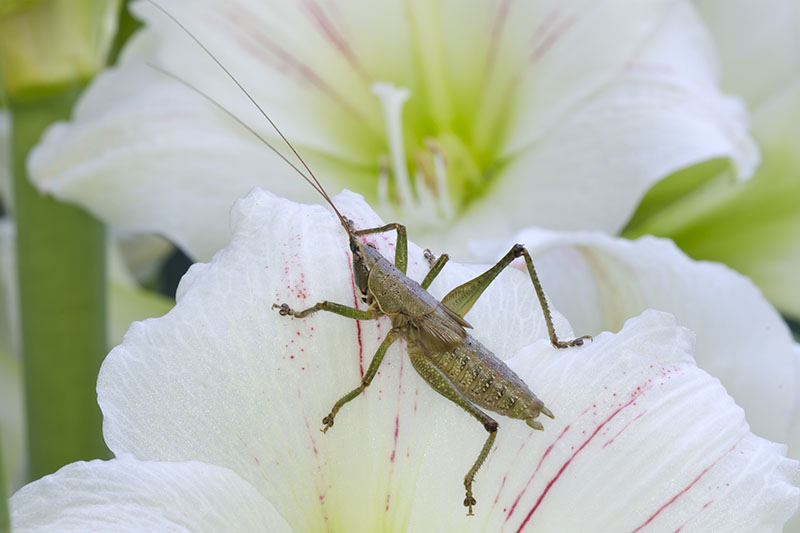
And finally, grasshoppers may move into the garden to feast on foliage, especially if there are tall weeds nearby.
The lubber variety is fond of amaryllis. Hand pick if possible, or for large infestations, apply Bt, a biological treatment, or a pyrethroid insecticide.
Common diseases include red blotch and soft bulb rot.
Red blotch appears as rusty patches on foliage that often progress to the point of plant collapse. With proper sunlight and watering, it can be avoided.
Commercial growers sometimes apply fungicide or soak affected bulbs in warm water for 30 minutes, but efforts are often futile. Discard entire affected plants.
Southern blight is a fungal infection that can occur in oversaturated soil. Once affected, rotted lesions develop and foliage softens, decays, and dies.
In addition, hungry rodents may eat entire bulbs, or damage them enough to make them vulnerable to infestation and infection.
Deterrents include lining planting holes with loose-weave screening at the time of planting, submerging pots in the ground to form a barrier, and growing above ground in containers.
Best Uses
Where the weather is warm, springtime affords the opportunity to enjoy these flowers in the garden, or to cut them to display in vases indoors.

Plant en masse for armloads, or dot the garden with odd-numbered groupings of three or five for colorful focal points within a larger design.
From beds and borders to containers, both indoors and out, these beautiful flowers make excellent gifts for fellow gardeners, and with so many exciting varieties available, are sure to become favorite in the spring garden.
Starry Dazzlers
With a location in full sun to part shade, and organically-rich, well-draining soil, you can grow tropical amaryllis in your Zone 9-11 garden year-round, for magnificent springtime blooms.
All that’s left now is to choose your favorites. Will you create a monochromatic display, alternate colors, or mix it up?
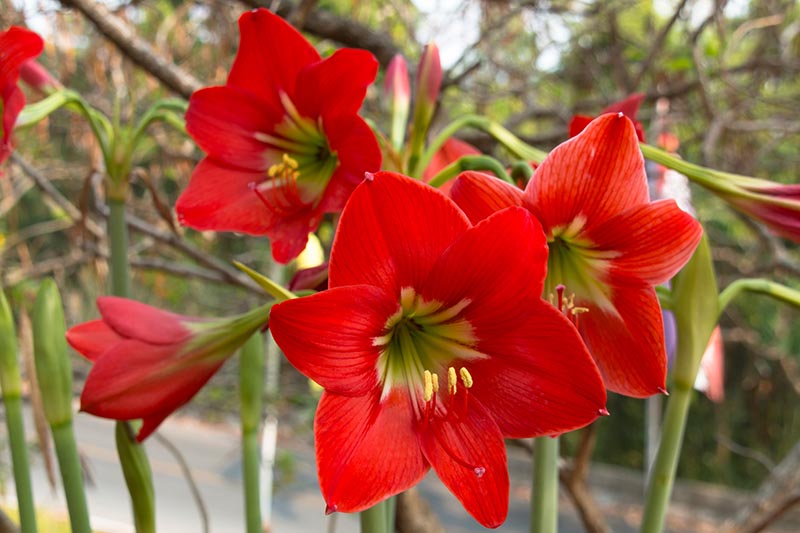
These colossal, starry blooms are sure to take center stage in your spring garden, so make room and prepare to be dazzled.
Do you grow amaryllis outdoors? Would you like to share your tips? Please do so in the comments section below.
And for more information about growing flowers in your garden, please consult these guides next:
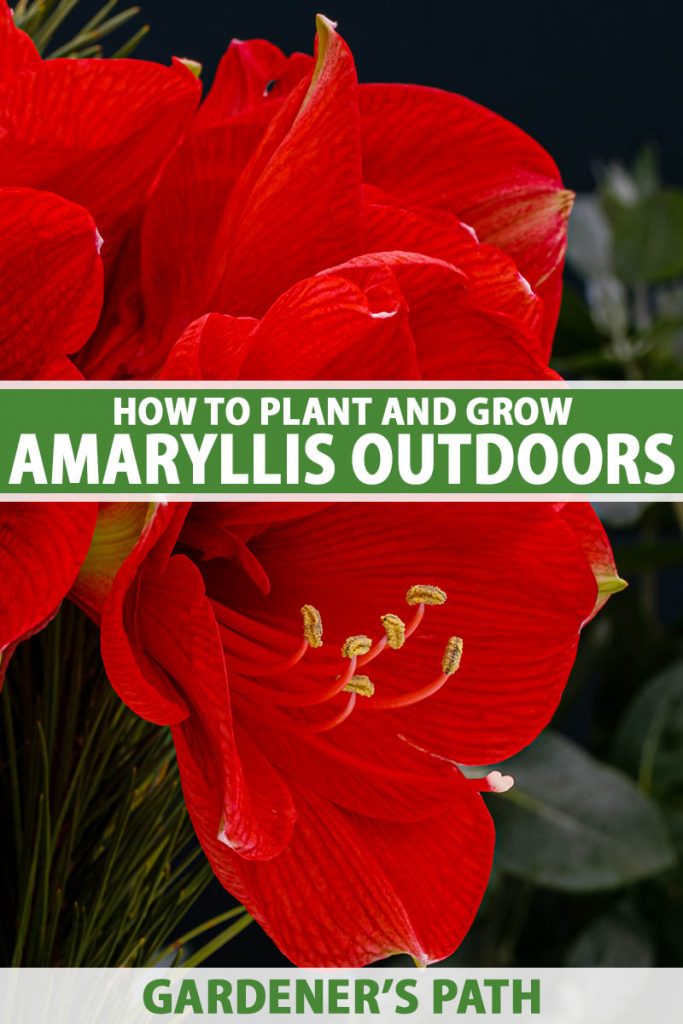
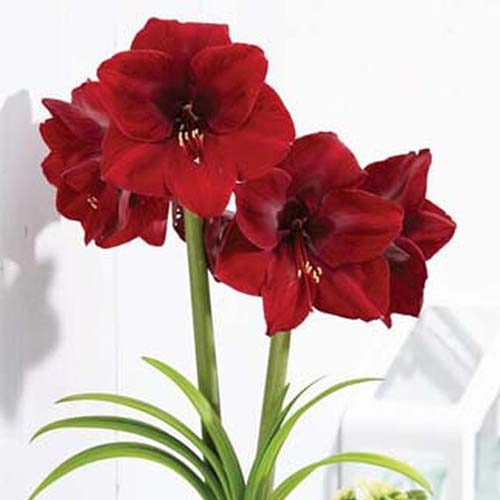
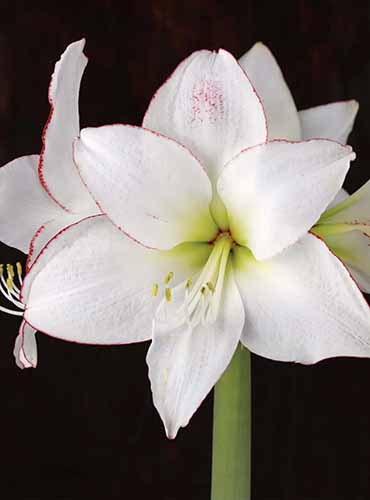

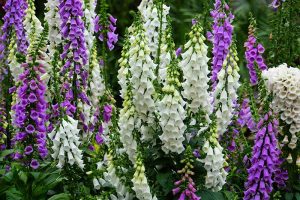
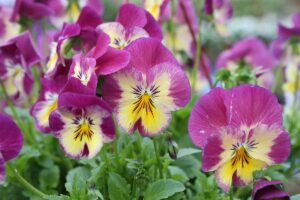
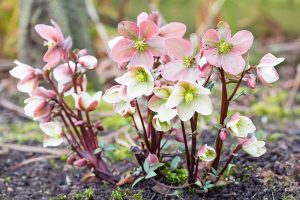
I did not see what to do with them as perennials in the south. Should I cut the old leaves off in the late winter to make room for new leaves?
Hello Joe –
Allow the old leaves to wither on their own, as they are feeding the bulb for next year’s flowers.
Nan, I have 4 Amaryllis in my flower garden outside here in Middle GA. The bulbs have been in the garden 4=5 years. Currently I have two plants who’s blooms are at ground level. I see no signs of fol;age damage-discoloration or other obvious problem. The others are doing fine. They are not planted as a group.. I would appreciate some help with possible causes and treatments.
Hi Helen –
This can happen when bulbs are too wet or are undernourished.
Be sure to avoid watering until you see sprouting, and then allow the ground to almost dry out before watering again.
Fertilize at the time of sprouting.
And after blooming, leave the foliage attached to wither naturally, so it can feed the bulbs for next year’s flowers.
Morning! I am new to the amaryllis family and would appreciate as much info as possible.
Hi Rita, welcome! You can find all of our articles about growing and caring for amaryllis here. Feel free to ask questions you may have.
I am selling my Mothers home due to her death. It is located in Birmingham, Al. I have dug up all her beds of outdoor Amaryllis. They had not bloomed in several years and I realize now they should have been divided sooner. Now I have 50+ bulbs that need to go somewhere. When they have been in the ground like this for years can you clean them off and store them as you said in article in a cardboard box? Or for best results, be planted now? They have been out of the ground now for two days but… Read more »
Hello Judith –
We are so sorry for your loss.
In your region, dividing and transplanting is usually done by mid-November. At this point, it would be best to wash, dry, and store the bulbs in a cardboard box in a cool, dry location, with a temperature in the range of 45-50°F.
My bulb bought from Aldi I planted at Christmas just grew 1 inch and that’s as tall as it got. Have grown before and great.
Hi Doreen –
An amaryllis bulb needs a snug fitting pot with no more than an inch of space around it. It does not require water until it sprouts, and then only when the soil surface feels dry. Monthly or bimonthly fertilizing with a well-balanced soluble product, sunlight, and warmth all contribute to healthy growth. And sometimes, even with our best efforts, we get a bulb that just doesn’t perform well.
I’m still unclear about Zone 9a amaryllis care. It’s late November and mine are green and healthy with large bulbs. They’re in pots. Do I move them into garage? Take out of dirt and put into refrig? Cut back the leaves? Or not? They’re not yellowing so do I just keep fertilizing to get blooms?
Hi Joyce – Let the green leaves remain in place to feed the bulbs. Now is the time to stop watering and fertilizing and let the leaves wither on their own. An eight to 10-week resting period and cool winter temperatures should stimulate blooming in late winter to early spring. In zone 9a, you can leave amaryllis plants in the ground year-round. However, if you are growing them in pots, it’s as if you were one zone colder, or zone 8a. You’ll need to bring the pots into the garage and wrap them in newspaper if the temperature dips to… Read more »
Hi Joyce –
Where amaryllis grows outdoors year-round, you can induce dormancy by withholding fertilizer and water in the fall. The foliage with yellow and wither at this time.
I have heard if you plant different colors of amaryllis in the same bed they will all become one color. Is this true?
Hi Gail – It is always possible for flora to exhibit color changes that may affect all of the species in a particular location. Factors that may affect amaryllis color are sun exposure, soil nutrients, and cross pollination. In addition, offshoots of a hybrid parent bulb may revert back to the color of one of the parents used in cross breeding. If multiple bulbs of the same variety are planted, it’s possible for the offshoots to become predominant as the parent bulbs are exhausted. And if these offshoots all revert back to the same parent color, they may all exhibit… Read more »
I was given one Amaryllis bulb by a friend who in turn had received it from someone else. All I know for sure is that when I first saw the plant it had very long floppy leaves that were turning yellow. We cut them off and let the bulb go dormant for about 6 months, Then we planted it again indoors in a container pretty much as everyone says you should. VERY small leaves began to sprout almost immediately but didn’t grow until I repotted the bulb and gave it plenty of water. Since then, 2-3 months, the leaves have… Read more »
This is not uncommon with potted amaryllis, but you should be able to get yours to bloom again with the proper treatment. First, green growth needs to die back naturally to provide nutrients for the next season’s developing flowers. After that, amaryllis needs a period of cool temperatures during dormancy to produce blooms. See our guide to forcing blooms for instructions.
I planted 6 bulbs 20 years ago. Since then, I have given away hundreds of bulbs (I am well liked by my friends!) Recently, I needed a tree removed from the front yard. Before allowing it to be cut down, I removed the Amaryllis patch near the tree. I pulled out 77 bulbs and gave most of them away. Two weeks after tree removal, I put down one inch of new soil and planted 30 bulbs. Did not do anything with the bulbs other than take them out and replant two weeks later. Will they survive? What would you have… Read more »
Hi Dean –
It’s best to transplant dormant amaryllis bulbs, but you can also dig and move them as soon as the flowers wither. Once lifted, they should be immediately replanted.
Amaryllis bulb foliage should be left in place to wither naturally, as it feeds the bulb for the next round of blooming. As long as your bulbs were not deprived of this nutrition and were kept cool and dry during their time out of the ground, they should bloom again.
I wish there was more information regarding the Narcissus fly attacking amaryllises planted in the ground. First time planting outdoors last summer, and all 4 bulbs were affected, with an actual grub in one of them, damage to the center of the bulb in two more and fairly minor damage to the last one. I knew nothing about them being a risk. Even the FB amaryllis group members don’t know much or anything about them, so how do people grow these large swaths of bulbs without being wiped out? I’m in NY, so we have to dig and bring in… Read more »
Hi JessE – Thank you for bringing this troublesome pest to our attention. The adult narcissus bulb fly, Merodon equestris, looks like a little golden brown bee. It lays eggs at the leaf bases in late spring or early summer. The emergent larvae enter the bulb and feed on it, but the damage isn’t evident until the fall, when those who lift their bulbs find them soft and moist. The Pacific Bulb Society suggests applying a garden insecticide to the base of the flowering bulbs as the foliage withers in late spring as a deterrent to egg-laying females. Lifted bulbs… Read more »